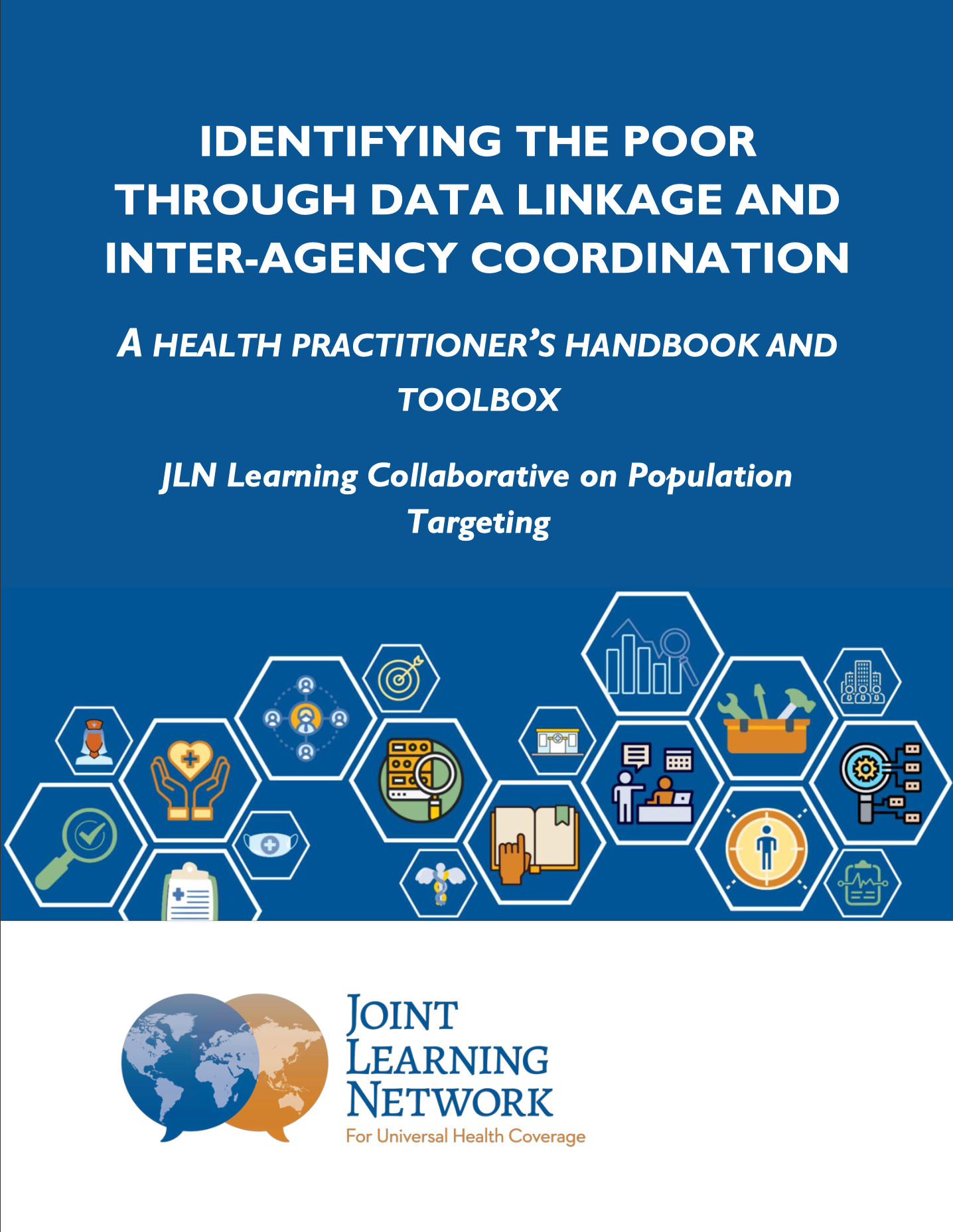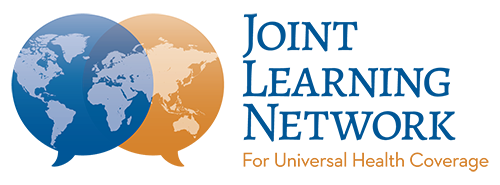Data Linkage Between Health and Non-health Agencies for Population Targeting

A Health Practitioner’s Handbook and Toolbox for Identifying the Poor and Vulnerable > Data Linkage Between Health and Non-health Agencies for Population Targeting
This toolbox is supplementary to the Health Practitioner’s Handbook, and can be used to address the specific next steps identified by the Handbook’s diagnostics. For more information about how the handbook and toolbox can work together, please visit the handbook page.
On this page you can access Data Linkage resources developed as a checklist to assist health leaders to move through the necessary steps towards their vision of linked population targeting data. The checklist is divided into three sections, with each of the 24 checklist items linked to a specific implementation resource.
Is your beneficiary data ready to link with other programs targeting the poor and vulnerable?
Data linkage for population targeting is the ability to bring multiple datasets from health and non-health sources together to enhance completeness, accuracy, richness and timeliness of population targeting data. It does not necessarily entail creating one central registry, nor does it require full integration. Instead, the goal is sufficient interoperability to share population data from one agency which will enable targeting decisions by another.
A system’s starting point makes a major difference to which model of data linkage is most viable, as health will typically be one of many different agencies contributing and using population targeting data. These different options are all described in detail in the ‘Data Linkage’ chapter of the Health Practitioner’s Handbook to Identifying the Poor and Vulnerable (available here).
From a practitioner’s perspective however, all of the different options require a similar set of requirements and stages: for example, data standards, storage, management and analysis across different agencies and programs, typically supported by some form of unique identifier (or a proxy).
The following ‘decision checklist’ has been created to work through each of the stages where health leaders face key choices and tasks. Each question in the checklist is accompanied by a specific tool designed to assist with this implementation work.
Detailed explanations of each question are given in the full handbook (here), but a summary list is presented below alongside each tool that has been created or curated to support implementation on this issue. The full list of tools with their titles is available below.
Click here to access the full Data Linkage Toolbox
Tool B1: Examples of multi-agency and cross-government data governance and IT working groups, including Mexico National Digital Strategy Office under Office of the President; Uruguay Agencia de Gobierno Electrónico y Sociedad de la Información (AGESIC) under Office of the President; Singapore Smart Nation and Digital Government Group (SNDGG); Moldova e-Government Center/Govt. CIO Office under PM Office; and Mauritius Central Open Data Team under IT ministry.
B3: An annotated list of useful interoperability frameworks and guidance, including global standards such as the European Union, International Social Security Association, IW3C, OASIS, the Open Group, as well as the Global Interoperability Framework building blocks, and Levels of Information System Interoperability Framework maturity model.
Tool B5: Comprehensive information system assessment tool, Social Registries for Social Assistance and Beyond : A Guidance Note and Assessment Tool (Leite et al. 2017)
Tool B7: Global best practice report World Bank (2018) “Public Sector Savings and Revenue from Identification Systems: Opportunities and Constraints” International Bank for Reconstitution and Development/The World Bank.
Tool B9: A best practice report on creating unique digital identity systems, World Bank (2019) “Identity for Development (ID4D) Practitioner’ Guide” Version 1.0 (October 2019). Washington, DC: World Bank. License: Creative Commons Attribution 3.0 IGO (CC BY 3.0 IGO).
Tool B11: A collection of global best practice guides and tools for data cleaning
Tool B12: A guidance document on data matching across agencies to support interoperability
Tool B13: Checklist of things to consider in any operational plan for data integration
Tool B14: Click here to access an example of such policies from Indonesia’s Management Standards for its Unified Database for Social Protection Programmes, Indonesia National Team for the Acceleration of Poverty Reduction (TNP2K), 2015.
Tool B16: Two best practice reports on data protection for social protection in low and middle income countries: (i) GIZ (2020) “Data Protection For Social Protection: Key Issues for Low And Middle Income Countries” Social Protection Interagency Cooperation Board (SPIAC-B). GIZ. and (ii) SPIAC-B, Good Practices for Ensuring Data Protection and Privacy in Social Protection Systems, GIZ.
Tool B18: A checklist of dos and don’ts in vendor outsourcing for data linkage projects.
Tool B19: A list of possible capacity building interventions to upskill key staff involved in a data linkage initiative, in Section 4.1.3 of Barca (2017), Integrating data and information management for social protection: Social registries and integrated beneficiary registries. Government of Australia Department of Foreign Affairs and Trade.
Tool B20: A practitioner experience and global best practice guide on methods and frequency of data updating.
Tool B22: Two best practice reports on recertification and data updating for population targeting systems in low and middle income countries: (i) Barca, V and Hebbar, M. (2020) “On-Demand and Up-To-Date? Dynamic Inclusion and Data Updating for Social Assistance” Deutsche Gesellschaft für Internationale Zusammenarbeit (GIZ) GmbH. and (ii) Medellin, N (2015) “Moving Ahead: Recertification and Exit Strategies in Conditional Cash Transfer Programs” Inter-American Development Bank. IDB.
Tool B24: ISSA ICT Guidelines 53-59, which outline best practice on the different forms of data analytics, including big data, machine learning and artificial intelligence.
Decision Checklist on Data Linkage for Population Targeting
Institutional Readiness
1.1. Is a whole-of-government data governance structure/agency in place? If not, what purpose-specific data sharing working group can be put in place? See Tool B1.
1.2. Is there agreement on the key agencies to involve in the data interoperability process, including those beyond the health and social protection sectors? Are all necessary agencies signed up? See Tool B2.
1.3. Is a data interoperability framework in place? If not, who is responsible for developing this? See Tool B3.
1.4. Is there a data sharing service agreement or protocol which will regulate data sharing across agencies? See Tool B4.
1.5. Has an assessment been conducted of existing/legacy systems that are in place in the key agencies? See Tool B5.
1.6. Has a business case for the data sharing/integration been developed (including incremental investment needs) and presented to core budgeting agencies? See Tools B6 and B7.
Data and sharing readiness
2.1. Are agreed data standards and dictionaries in place, or a process to develop them? See Tool B8.
2.2. Is there a common/unique identifier for households/individuals or – if not – can one be created? See Tool B9.
2.3. Are any adjustments required in the business processes for data management and operational workflows in the agencies sharing data to ensure smooth data exchange and use of shared data in operations? See Tool B10.
2.4. Has source data in key agencies been cleaned and validated according to common standards, and is there agreement on “clean enough” data thresholds? See Tool B11.
2.5. In addition to data cleaning by individual agencies, has a process been agreed for data harmonization? See Tool B12.
2.6. Is there an operational plan for the data interoperability project? See Tool B13.
2.7. Do policies and procedures for requesting access to and use of the data exist? See Tool B14.
2.8. Are systems and protocols for data security and privacy in place? See Tools B15 and B16 (i) and (ii).
2.9. Is a testing (e.g. prototyping or alpha/beta testing) and/or piloting phase planned? See Tool B17.
2.10. Will outsourced software vendors be used in developing data sharing software/platforms? If so, has a detailed specification for their work been designed? See Tool B18.
2.11. What human resources are in place in each key agency to manage data matching and sharing and are they adequate? What HR capacity enhancement is needed to make the data sharing work smoothly? See Tool B19.
Updating, using, and analyzing the data
3.1. How will integrated data be kept up to date, and who is responsible for this? See Tool B20.
3.2. Is bi-directional updating planned, so that updating becomes a shared responsibility? See Tool B21.
3.3. Have common challenges/pathways/options for recertification and data updating been considered? See the Data Linkage Toolbox above for Tool B22.
3.4. Have the rights and roles of agencies to analyze the newly integrated data been agreed, and do they have the skills to do this? See Tool B23.
3.5. What decision support and analytics systems exist in the participating agencies to maximize the value of population targeting data for operational, oversight and policy development purposes? See Tool B24.
Want to see these tools in action? Read the implementation country case study for Ghana here.
